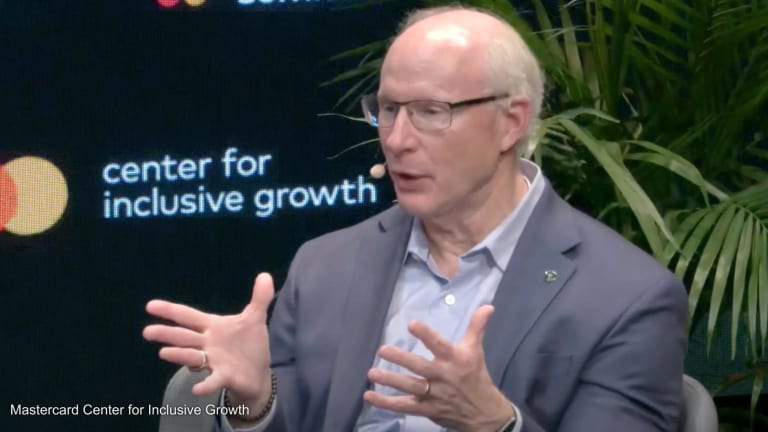
NEW DELHI — The growth in India’s mobile phone market has helped an unexpected sector — impact investing.
Mobile phone penetration and data access in India has increased dramatically over the past 18 months, in part due to dropping data costs. The growth is making it possible for new groups of people to access information, jobs, education, transportation, financial services, and health care — creating both business and investment opportunities, according to Roopa Kudva, managing director of Omidyar Network India Advisors.
“Increasingly, I believe that an entrepreneur that has a broader social good at their core is an essential element to tackle some of India’s most difficult problems.”
— Roopa Kudva, managing director of Omidyar Network India AdvisorsGrowing access to mobile phones is one of the driving forces behind India’s social impact businesses and is giving rise to the growth of impact investing in the country, said Kudva, who is also a partner at the Omidyar Network.
India’s impact investing market has grown rapidly in the past few years — the total value of impact investments in India since 2010 has been $5.2 billion, according to a McKinsey report — and $4.2 billion of that is since 2015. In that time, average deal sizes have increased — from $7.6 million in 2010 to $17.6 million in 2016, though the number of investments has stayed between 60-80 a year.
Impact investors are often the first investors in social enterprises, with private equity or venture capital firms coming in at later stages as they grow. Impact investing enables the growth of entrepreneurship, but a strong ecosystem for social entrepreneurs is also critical to the growth of the impact investing industry.
Many eyes are on India to see if it can succeed in building a robust domestic impact investing industry and what role it can play in the country’s development efforts. While the country has a much larger market than most, lessons learned there could help efforts elsewhere.
“We’ve been an independent country 70 years, if you look at where India stands on social indicators, the ranking is low across a range of indicators despite progress. The government is doing its best, but increasingly, I believe that an entrepreneur that has a broader social good at their core is an essential element to tackle some of India’s most difficult problems,” said Kudva.
And there is potential for growth in funding those enterprises. The McKinsey report found that impact investments in India have the potential to grow between 20-25 percent by 2025, adding up to between $6 billion-$8 billion invested. But the sector is still navigating a shifting landscape, a number of key challenges around measurement and growth, and will need more collaboration moving forward, investors said.
A shifting landscape
Shifting culture, growing capital markets, and the rise of mobile phones are all changing the impact investing landscape in India, creating more opportunities as awareness grows.
The Omidyar Network has been investing in India for about 10 years, committing some $250 million and working to raise awareness about impact investing. Indian investors are also emerging and beginning to consider impact. Aavishkaar, one of India’s largest impact investing firms, which has a mission to back early-stage businesses that target the poor, has been able to attract Indian investors in addition to foreign investors. But there is still progress to be made to get more on board.
Kudva said that there have been three key shifts that are spurring growth and opportunity in the impact investing space in India: increasing awareness in the concept of impact investing, philanthropists looking to be more strategic, and a growing entrepreneurship ecosystem.
More on impact investing:
► IFC releases draft impact investment guidelines
► At the Vatican, a different type of investing conference
► Opinion: Social impact, India’s next growth and employment engine
In 2014, India made it mandatory for companies of a certain size to spend 2 percent of their average net profit on corporate social responsibility and directing them to take a systemic approach. With the passage of that law, philanthropists began taking a more strategic approach and began realizing impact investing could be a part of their work, Kudva said.
There have also been some cultural changes that are contributing to the ability of impact investing to grow, including the fact that working for a startup is now considered acceptable by India’s middle class, she said.
There is now acceptance that for-profit ventures can deliver social good, whereas there used to be a belief that “nonprofits do good and businesses do bad,” said Geeta Goel, the Michael & Susan Dell Foundation’s India Country director.
Role models in the industry are also leading to more acceptance of impact investing and more change. “As an industry, we want to show scale and financial viability,” she said.
Another shift has been with the people who are interested in working to solve India’s problems, Kudva said. About 15 years ago, it was people from a social science or social service background, but today, that group includes scientists and engineers. This generation of Indian entrepreneurs wants to solve problems, not just build businesses, she said.
Challenges
As the industry works to grow, there are a number of concerns and debates, some of which reflect broader conversations happening around the world.
In India, there is a lot of talk about impact investing producing market returns, and while there are categories where that is true, in some places or industries, those opportunities do not exist, Kudva cautioned.
Impact investors need to be clear about when they take below-market returns — Omidyar will do so when that investment will help shape a market and is creating a new replicable business model, sector-level infrastructure or policy reform. If conversation about impact investing doesn’t include the issue of subcommercial returns, there is a risk it will “lead to disappointment,” she said.
Another concern is deal size. As some impact firms have seen success and seek to grow, they often move away from investing smaller amounts in earlier-stage companies and invest more in larger, more established companies. It is difficult to scale significantly while still investing small amounts of money, but as firms grow, there are concerns that young businesses will find it difficult to get the smaller amounts of money they need to get started.
When those companies can’t get early-stage investments, the pipeline for larger funds also dries up, Goel explained.
Entrepreneurs and investors both said that impact capital has also been concentrated in a number of sectors, particularly in financial services, and businesses outside those favored by investors have trouble attracting capital.
“It is easier for an investor in America or Europe to relate to an Indian techy than it is to relate to an Indian supply chain manager.”
— Pravesh Sharma, co-founder and CEO, Kamatan Farm TechWhile technology may be attracting investors, other sectors, such as agriculture, or agricultural processing, are having a hard time raising funds, said Pravesh Sharma, co-founder and CEO of Kamatan Farm Tech, an agriculture processing company.
“It is easier for an investor in America or Europe to relate to an Indian techy than it is to relate to an Indian supply chain manager,” he said.
While the opportunity in Sharma’s eyes is unlimited — the country has some 130 million farmers — only a handful of investors have started to understand the agriculture potential, he said.
What’s needed
Better measurement, more collaboration, regulatory changes, and more capital are all needed to spur growth in the industry, according to investors.
While perspectives have changed, new investors need to come online, and they need proof of success. The track record being built by local investors such as Aavishkaar and others including LeapFrog Investments, is helping to convince investors of value.
LeapFrog had five “exits” where it sold its stake in a company in India in 2018, and the market is maturing with more companies coming through the ecosystem, said Andrew Kuper, the founder and CEO of LeapFrog. The key issue is ensuring that investors and other actors in the industry work together to create an ecosystem that includes investors across the spectrum, with opportunities for early-stage investors to be bought out by others down the line.
“We need to mature the whole ecosystem to make early-stage [investments] work,” he said. “Demonstration is the key. Strong returns, big impact, and clear metrics and transparency is what will do it.”
But it’s not only impact investors that need to be convinced to engage. Part of the challenge for impact investors is that entrepreneurs often want mainstream investment, not impact investments, as mainstream investors tend to have a larger risk appetite and deeper pockets, said Varun Pawar, Village Capital’s associate for strategies and partnerships in India.
If there is more money, particularly in rupee funds, it could help, but many social enterprises are choosing money over impact, he said. And others, often who are working to solve some of the hardest problems, struggle to raise capital from impact investors.
Platforms including the Global Steering Group for Impact Investment and the Impact Investing Council are important to bring different actors together, share lessons, influence policy, and help to spur growth in the industry, Kudva said.
Nonprofit and for-profit industries typically work in silos and rarely collaborate, the Dell Foundation’s Goel said, so creating platforms that can bring together nonprofit, for-profit, and government is necessary for the industry to scale. Those platforms can also help attract more capital to the sector, Goel added.
“We also need to up the pressure on impact measurement and management,” she said. Several investors are measuring impact but often with different metrics that aren’t comparable and might not be good enough. While it is hard to find the right set of standards, without a strong set of metrics there are two key risks: that the lowest common denominator will be used for measurement or financial impact will drive deals and not high degrees of impact, Goel said.
India also likely needs more fund managers, creating companies that will work along the spectrum of investment size and giving companies more options when they seek capital. Development agencies can help to support the creation of those new companies.
A number of other factors including government regulations, particularly an amendment to the corporate social responsibility law that would allow some of those funds to be directed to social enterprises, and new types of debt funds or products are also needed.
Editor’s note: The Global Steering Group for Impact Investment facilitated Devex's travel for this reporting. However, Devex maintains full editorial control of the content.








